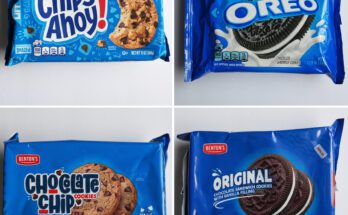
Snack Wars: Mondelez Sues Aldi Over Look-Alike Packaging
A major legal clash has erupted in the snack world: Mondelez International, owner of household brands like Oreo, Chips Ahoy!, Wheat Thins, and Ritz, is suing discount supermarket chain Aldi, accusing it of selling private-label cookies and crackers with packaging that “blatantly copies” its signature designs to confuse customers.
🔍 What’s the Lawsuit About?
Filed on May 27, 2025, in federal court in Illinois, the lawsuit claims Aldi’s packaging closely mimics Mondelez’s trade dress—including color schemes, fonts, layouts, and imagery—to “ride the coattails” of the snack maker’s reputation (fooddive.com).
Examples from the complaint include:
- Aldi’s Thin Wheat crackers in gold boxes resemble Wheat Thins.
- Aldi’s Original Chocolate Sandwich Cookies sporting blue packaging mimic Oreo.
- Aldi’s Golden Round crackers closely resemble the iconic red boxes of Ritz (wsls.com).
Mondelez previously flagged similar packaging for products like BelVita and Teddy Grahams—but alleges Aldi only changed or discontinued some items, while continuing to “infringe” on others (people.com).
🎯 Why Mondelez is Taking Action
Mondelez argues Aldi’s tactics cause consumer confusion, falsely suggesting an affiliation with its trusted brands, and risk brand dilution—all part of an alleged pattern of unfair competition (insurancejournal.com).
The company is seeking:
- A court order (injunction) to make Aldi stop selling the infringing products.
- Damages, including treble damages, attorney’s fees, and punitive awards (washingtonpost.com, news.com.au, people.com).
🛒 Aldi’s Response (or Lack Thereof)
Aldi has not publicly commented on the lawsuit. The lawsuit notes prior communication from Mondelez to Aldi—and that Aldi allegedly altered some packaging, but continues to sell others without change (wsls.com).
Aldi, founded in Germany, operates over 2,500 stores across 39 U.S. states, using a low-cost private-label model that often features products visually similar to major brands (washingtonpost.com).
🔄 Past Packaging Disputes
This isn’t Aldi’s first run-in over packaging:
- 2018 (Australia): Allianz sued and found Aldi guilty of copying Baby Bellies puff snack packaging (abc.net.au).
- 2024 (UK): Aldi lost an appeal against Thatchers Cider over bottle design (abc.net.au).
💡 Why This Matters
- Consumer protection: Shoppers expect transparency—not confusion caused by packaging mimicry.
- Brand integrity: Distinctive packaging represents years of marketing and brand building.
- Private-label limits: As private brands grow, this case could redefine how closely they can resemble national brands without crossing legal lines.
TL;DR for Brands and Shoppers
| Role | What to Know |
|---|---|
| Consumers | Be critical in the snack aisle—price isn’t the only factor to consider. |
| Brands | This suit signals that companies will aggressively defend their trade dress. |
| Retailers | The case could force stricter guidelines on private-label packaging designs. |
We’re paying close attention: this could reshape how your favorite grocery chains package their store-brand snacks. Stay tuned.
Snack Wars: Mondelez Sues Aldi Over Look-Alike Packaging Read More